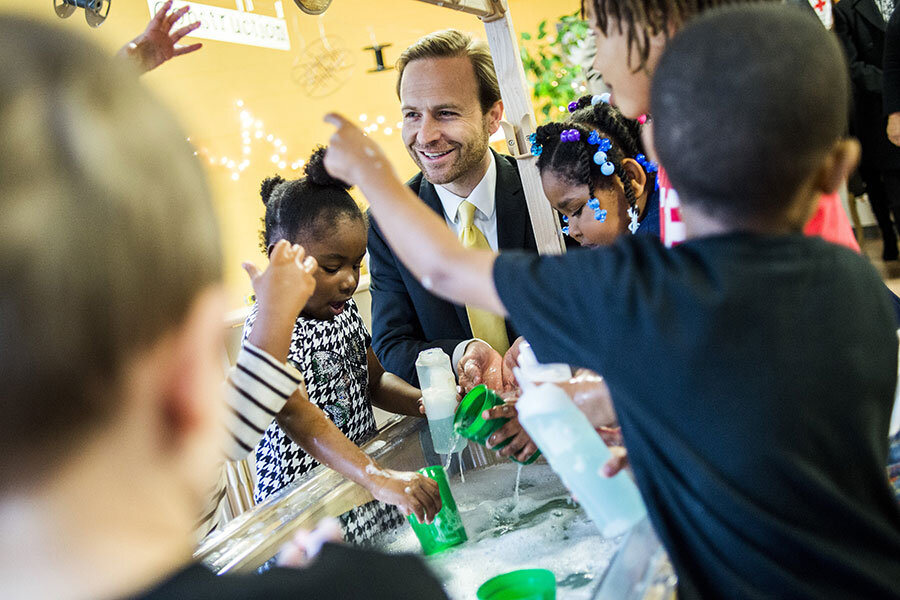After Flint, are schools being more vigilant about tainted water?
Loading...
From Oregon to Maine, the Flint, Mich., water crisis is leading to action in the nation’s schools.
Massachusetts expects to complete testing of about 930 schools by January and is making results available online.
Chicago Public Schools plans to test all its facilities and post the results online.
And New York State has gone furthest, passing a first-of-its-kind law that required schools to test by Oct. 31, report results quickly, and take corrective action when needed.
The action is an acknowledgment that the largely voluntary testing system present in most of the country isn’t sufficient.
But the actions taken are, in most cases, a bare minimum, experts say. Officials know that the problem of lead pipes extends far beyond Flint, so the need is still for parental and public pressure to push for more rigorous testing.
“If you haven’t heard bad news about lead in your schools’ water, you ought to check and see why,” says Marc Edwards, a civil and environmental engineering professor at Virginia Tech who helped expose the Flint crisis. “Is it because they have done good testing and they’ve really shown there’s no problem, or have they done deceptive testing … or have they done nothing?”
In 2006, about half of states were making no efforts to detect lead in school drinking water, and only a handful had a comprehensive program, the Government Accountability Office reported. It’s difficult to assess how much school testing and transparency have improved since Flint, but news reports offer examples of actions taken by several states and school districts:
- New York is the only state to pass a law requiring school water testing, though others have mandated it through health departments. The state Department of Health plans to post the results of the new round of testing online soon, according to a spokesperson. The Buffalo News recently reported that some districts in upstate New York had made the information readily available on their websites, while others were lagging.
- The Oregon Health Authority recently posted an interactive map, searchable by school name, with detailed information about schools that have tested their water. The state Department of Education requires schools to create a plan to test drinking water for lead.
- New Jersey issued state regulations in July giving schools one year to test their water for lead, and set aside $10 million for reimbursing the costs.
- Massachusetts set aside nearly $3 million for testing. A Boston Globe analysis found that of 300 schools tested, about half had at least one source of water with a problematic lead level.
Testing faucets can be a hit-and-miss proposition, even if done regularly, which underlines the importance of constant vigilance. As pipes or solder corrode, particles of lead can show up even at taps that previously tested clean, Dr. Edwards says. In one kindergarten classroom, for instance, about 10 samples showed no problems, but in two other samples taken from the same tap, the amount of lead was “over hazardous waste levels.”
In June, the American Academy of Pediatrics urged that water from school fountains not be allowed to contain lead concentrations above 1 part per billion. New York’s threshold is 15 parts per billion.
Sen. Tammy Duckworth (D) of Illinois has advocated for a federal standard, but it is doubtful she has enough congressional support. The most cost-effective solution might be to put filters on school taps designated for drinking and cooking – so long as they are certified and maintained, Edwards suggests.
The need is widespread, especially in poorer areas. Districts should spend about $145 billion a year to keep up with a range of health and safety standards, according to the 2016 State of Our Schools report. Currently, they spend about $99 billion.
But that spending is much higher in wealthier districts. From 1995 to 2004, schools in high-wealth ZIP codes spent at least triple what those in the lowest-wealth ZIP codes spent, the study found.
And across the board, state and local officials often only act when pushed.
In Portland, Ore., last spring, the school board requested an investigation by a law firm after elevated lead levels had been found at a school but not been revealed to parents right away. The report noted a lack of consistent procedures for the past 15 years, saying that other than the regular changing of some water filters, most actions were taken only in response to promptings by parents.
In Baltimore, repeated problems with lead in water also came to light through the persistence of parents, and in 2007 the district opted to supply bottled water for drinking rather than continue the cycle of testing and remediation.









